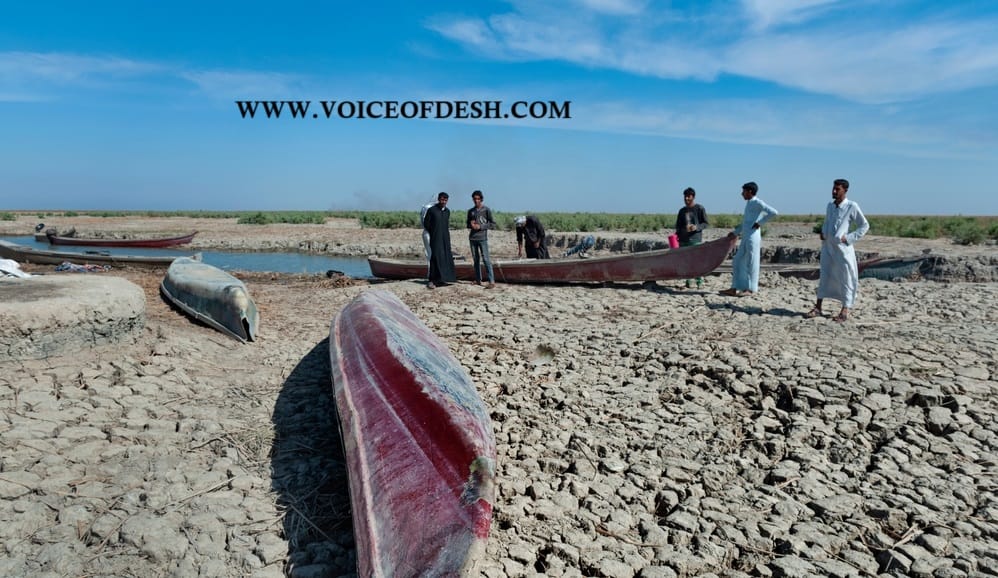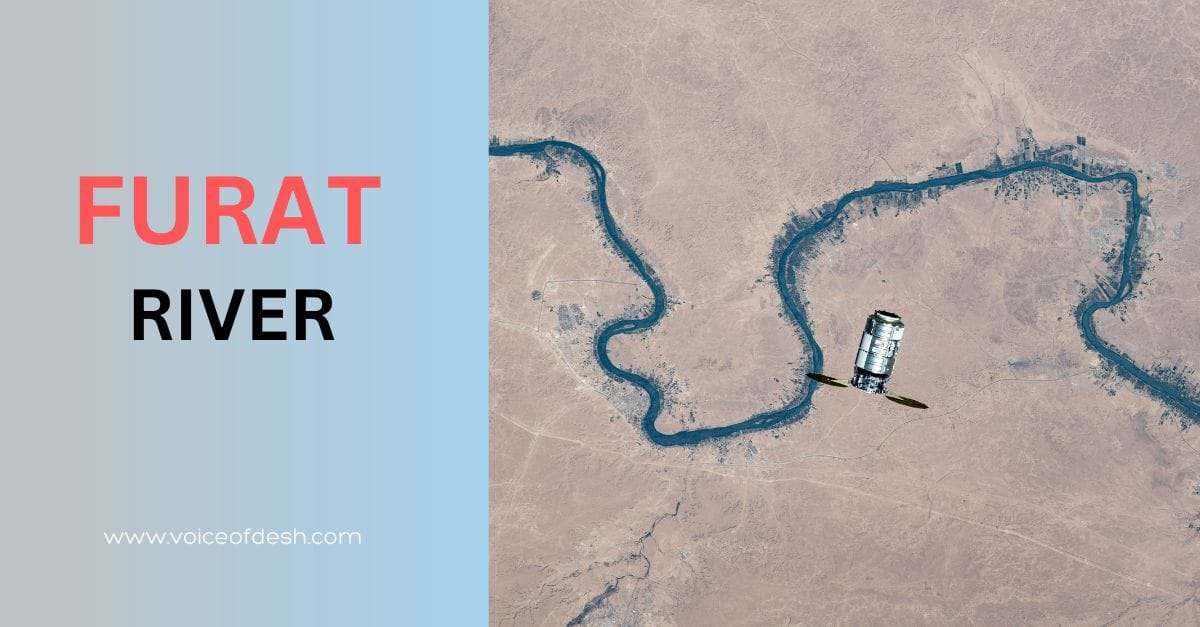The Furat River, often known as the Furat or simply the Euphrates, is one of the most historically significant rivers in the world, shaping the ancient landscapes of Mesopotamia and providing the lifeblood for civilizations dating back thousands of years. It flows through modern-day Turkey, Syria, and Iraq, stretching for approximately 2,800 kilometers (1,740 miles) and joining with the Tigris River to form the Shatt al-Arab before emptying into the Persian Gulf.
1. Geography and Source of the Euphrates
- The Euphrates River originates from two primary sources: the Karasu and Murat rivers in eastern Turkey. These tributaries converge near the city of Keban and then continue southward, winding through rugged landscapes and eventually flattening as the river flows into Syria and Iraq. The course of the Euphrates in Turkey is marked by deep valleys and mountain gorges, while in Syria and Iraq, it spreads out into vast floodplains, making the river a vital source of irrigation for agriculture in these arid regions.
2. Historical Importance of the Euphrates
- The Euphrates is deeply intertwined with the history of human civilization. It is one of the two rivers that formed the heart of Mesopotamia, often called the “Cradle of Civilization.” Ancient Sumerians, Akkadians, Babylonians, and Assyrians built their cities and empires along the Euphrates, taking advantage of its water to sustain agriculture, which allowed cities to flourish. Notable cities such as Ur, Babylon, and Mari rose along its banks, and the river played a central role in their trade, agriculture, and culture.
- The river also appears in numerous ancient texts and mythologies. In the Bible, the Euphrates is one of the four rivers that flowed from the Garden of Eden. The river has similarly symbolic meanings in Sumerian and Babylonian myths, often representing life, fertility, and abundance in the arid regions of the Middle East.
3. The Euphrates and Agricultural Development
- The agricultural systems of ancient Mesopotamia, particularly the development of irrigation, were significantly dependent on the Euphrates. Early inhabitants learned to harness the river’s waters through extensive canal systems, allowing them to grow crops like wheat, barley, and dates. The predictable flooding of the Euphrates deposited rich silt on the plains, making the soil fertile and ideal for farming. This development was key to the region’s ability to sustain large populations, which in turn allowed for urbanization and complex societies.
4. Modern Significance and Challenges
- In modern times, the Euphrates remains a crucial water source, but it faces significant challenges. Dams and water management projects in Turkey, Syria, and Iraq, such as the Ataturk Dam in Turkey, have altered the river’s natural flow, impacting agriculture, water availability, and ecosystems downstream. These developments have also led to political tensions among the countries that share the river, as each nation seeks to secure water resources for its own population.
- Furthermore, the Euphrates has been affected by climate change, with decreasing rainfall and rising temperatures contributing to reduced water levels. This has increased water scarcity in regions that rely heavily on the river, particularly in Iraq, where millions of people depend on it for drinking water and farming.
5. Ecological and Cultural Impact
- The Euphrates River supports a unique ecosystem, providing habitats for various species of fish, birds, and other wildlife adapted to its desert surroundings. However, water extraction and pollution have taken a toll on its biodiversity, endangering some species and disrupting traditional fishing practices. The river’s marshlands, particularly in southern Iraq, were once some of the most extensive in the Middle East, but they have been dramatically reduced by both natural and human influences.
- Culturally, the Euphrates remains symbolic in the Middle East. It continues to inspire literature, art, and local customs, as well as religious practices. Many communities along the Euphrates see it as part of their heritage and identity, and it holds a place of reverence for the historical legacies it has preserved.
6. The Future of the Euphrates
- The future of the Euphrates depends on regional cooperation and sustainable water management practices. There is an increasing call for treaties and agreements between Turkey, Syria, and Iraq to share the river’s resources equitably and prevent further environmental degradation. Efforts to rehabilitate parts of the river, especially the Iraqi marshlands, are ongoing, with hopes of restoring this vital ecosystem and supporting the communities that depend on it.
- With careful management, the Euphrates could continue to provide for millions of people, while preserving the ecological and historical significance that makes it one of the world’s most remarkable rivers.

Origins and Geography
The Furat River originates from two main tributaries in Turkey: the Kara Su and the Murat Su rivers, which converge near the town of Keban. From there, it travels southward into Syria and Iraq, moving through varied landscapes. In Turkey, it winds through mountainous regions, while in Syria and Iraq, it spreads out into broader plains, where it becomes vital for irrigation, agriculture, and daily life.
Historical Importance
The Furat River has been a cradle for some of the earliest human civilizations, particularly in the region known as Mesopotamia, which means “land between the rivers” (the Tigris and Euphrates). Civilizations such as the Sumerians, Akkadians, Babylonians, and Assyrians settled along its banks, using the river’s water for agriculture, transportation, and trade. Iconic cities like Ur, Babylon, and Mari developed along the Euphrates, and their cultures shaped much of human history. In religious and mythological texts, including the Bible, the Furat is one of the four rivers flowing from the Garden of Eden.
Agricultural Significance
The Furat has historically supported extensive agriculture through its seasonal flooding, which deposits nutrient-rich silt onto the surrounding land. Early societies in Mesopotamia developed advanced irrigation systems along the Furat, allowing them to cultivate crops like wheat, barley, and dates. This productivity supported dense populations and the growth of urban centers, contributing to the development of one of the world’s earliest complex societies.
Modern-Day Challenges
In recent times, the Furat faces several challenges. Dams and water diversion projects in Turkey, Syria, and Iraq have changed its flow, reducing water availability downstream and creating political tensions among these nations. Major dams, like the Ataturk Dam in Turkey, have affected the river’s natural flow and have had consequences for agriculture, drinking water, and ecosystems in Syria and Iraq. Additionally, climate change, with rising temperatures and decreased rainfall, has led to reduced water levels and increased scarcity, impacting millions of people who rely on the river.
Ecological Impact
The Furat supports diverse ecosystems, including fish, birds, and marshlands, especially in Iraq’s southern region. However, dam construction, water extraction, and pollution have put stress on these ecosystems, leading to loss of biodiversity and impacting local fishing industries. Efforts are ongoing to rehabilitate the Iraqi marshlands fed by the Furat, which are among the largest wetlands in the Middle East and home to unique flora and fauna.
Cultural and Symbolic Significance
The Furat River holds deep cultural and symbolic meaning for people in the region. Many communities along its banks view it as part of their cultural heritage and identity, and it is celebrated in literature, art, and religious practices. The river represents life and abundance in a region dominated by desert landscapes and has inspired countless works of poetry, stories, and traditions.
Future of the Furat River
The future of the Furat relies on sustainable water management and cooperation among Turkey, Syria, and Iraq. Regional agreements could help ensure that all nations have fair access to the river’s resources while protecting its ecological health. With appropriate management, the Furat could continue to serve as a lifeline for millions, preserving both the cultural legacy and natural environment of this ancient and vital river.
Geography and Physical Characteristics
The Euphrates River begins its journey in the highlands of eastern Turkey, originating from two main tributaries, the Kara Su and the Murat Su. These tributaries converge near the town of Keban in Turkey, from where the Euphrates flows southward across Syria and Iraq, covering approximately 2,800 kilometers (1,740 miles).
In Turkey, the river cuts through mountain valleys and narrow gorges, gradually widening as it descends into the Syrian plains. In Iraq, the Euphrates merges with the Tigris to form the Shatt al-Arab waterway, which continues to the Persian Gulf. This varied landscape has allowed the river to support agriculture, transportation, and settlement for centuries, making it a central feature of life in the region.
Historical Significance
The Euphrates, along with the Tigris, formed the region of Mesopotamia, the “land between rivers,” where some of the world’s first cities and states emerged. Ancient civilizations, including the Sumerians, Akkadians, Babylonians, and Assyrians, relied on the Euphrates for water, food, and trade. Early Mesopotamian cities like Ur, Babylon, and Mari developed extensive canal networks, allowing them to control and utilize the river’s waters for agriculture and sustenance.
In ancient texts, the Euphrates is often mentioned with reverence. In the Bible, it is one of the four rivers flowing from the Garden of Eden. The Euphrates also appears in Sumerian, Babylonian, and Assyrian myths, where it symbolizes life, abundance, and divinity. This rich history makes the Euphrates not only a geographical feature but also a deeply ingrained symbol of life and civilization in the Middle East.
Agricultural Importance
Agriculture along the Euphrates dates back to 6,000 BCE, as communities developed irrigation systems to harness its seasonal floods. The river’s waters allowed ancient Mesopotamians to cultivate crops like wheat, barley, and dates, providing the necessary resources to support large, urban populations. Surplus food enabled the growth of cities and the development of trade and specialized labor, marking a significant leap in human civilization.
The Euphrates’ irrigation systems, including canals and levees, became more sophisticated over time, allowing for year-round agriculture even in the hot, arid climate. These advancements in agriculture made Mesopotamia a powerful economic and cultural center, influencing the surrounding regions for centuries.
Ecological Significance
The Euphrates supports a unique and diverse ecosystem, particularly in its lower stretches in Iraq, where marshlands once spanned thousands of square kilometers. These wetlands, known as the Mesopotamian Marshes, are home to a variety of fish species, migratory birds, and rare animals adapted to the river’s seasonal changes. The river also provides critical habitats for freshwater fish and is an important stopover for migratory bird species, making it an ecological treasure in an otherwise arid region.
However, the construction of dams and water management projects has led to a significant loss of habitat and biodiversity. Efforts to restore parts of the Iraqi marshlands have shown promise, but the ecosystem remains fragile.
Cultural and Religious Importance
The Euphrates holds immense cultural and religious significance. In Islam, the river is mentioned as one of the four rivers of Paradise. Biblical texts, as well as Mesopotamian myths, reference the Euphrates as a divine and life-giving force. Local communities have long regarded the river as sacred, incorporating it into religious practices, art, and folklore. This symbolic role continues to inspire literature, art, and traditions throughout the Middle East.
Modern-Day Challenges
In recent decades, the Euphrates has been transformed by dam construction and water management projects in Turkey, Syria, and Iraq. The Ataturk Dam in Turkey, the Tabqa Dam in Syria, and the Haditha Dam in Iraq are major infrastructural projects that have altered the river’s flow. While these projects provide water storage, irrigation, and hydroelectric power, they have also caused tensions among the countries sharing the Euphrates.
Decreased water flow downstream has led to water scarcity, affecting agriculture, drinking water supplies, and natural habitats. In Iraq, reduced water levels have caused desertification and hardship for communities that have depended on the river for centuries.
Environmental Concerns and Climate Change
The Euphrates is under threat from climate change, with rising temperatures and decreased rainfall reducing water availability. Pollution from industrial runoff, agricultural chemicals, and untreated sewage also poses a risk to the river’s health. These issues are compounded by the increased demand for water from growing populations in the region, placing immense pressure on this ancient waterway.
Economic Significance
The Euphrates continues to support agriculture, fishing, and industry in the region, providing jobs and sustenance for millions. The river also holds potential for hydroelectric power, which could help meet the energy demands of Turkey, Syria, and Iraq. However, balancing economic growth with sustainable practices is a significant challenge that requires regional cooperation and long-term planning.
The Future of the Euphrates
The future of the Euphrates depends on sustainable water management and cooperation between Turkey, Syria, and Iraq. Treaties and agreements are essential to ensure equitable sharing of water resources and to protect the river from further environmental degradation. Conservation efforts, such as restoring the Mesopotamian Marshes and implementing pollution controls, could help preserve the river’s ecosystem for future generations.
Conclusion
The Euphrates River is not just a body of water; it is a living testament to humanity’s resilience, creativity, and adaptation over millennia. From ancient Mesopotamian societies to present-day challenges, the Euphrates has been and continues to be a vital artery for life and culture in the Middle East. The way forward will require balancing modern needs with respect for the river’s legacy and environmental health, ensuring that this ancient river can continue to nourish future generations.
And Monre post Now Clack







